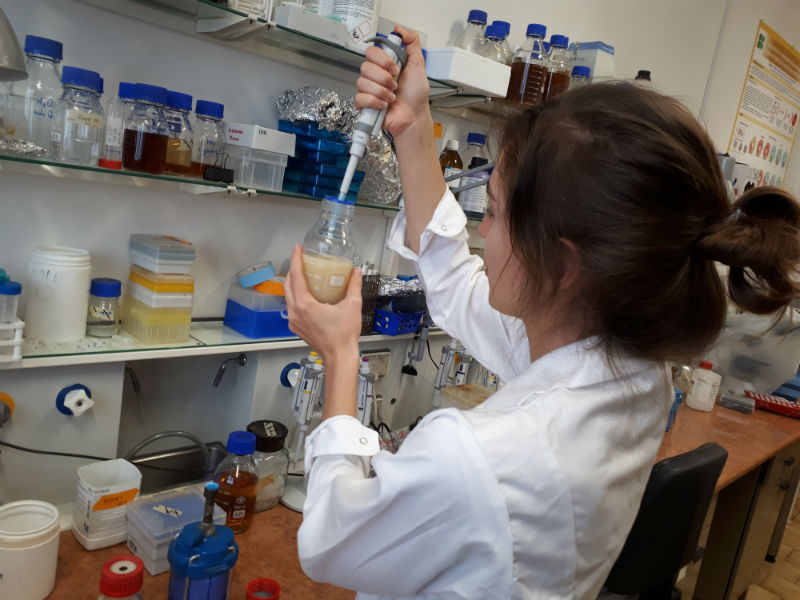Millet yoghurt
A student project to fit in with the trend
A millet-based yoghurt substitute is a new project taken up by the team of the “Herbion” Biotechnologist Student Research Group operating at WUT Faculty of Chemistry. The product is intended as a local and cheaper alternative to non-dairy yoghurts made of coconut, rice or soy milk that you can buy at stores.
“People who give up dairy products, e.g. because they are allergic to dairy and do not tolerate milk protein or because they choose to follow a vegan diet, often refuse to eat probiotic products,” says Cezary Piwowarczyk. “However, probiotics are very good for your digestive system, meaning your health. I thought we could try to find a substitute.”
Hence the idea of making grain-based yoghurt. The students chose millet for its valuable nutritional qualities. “It’s gluten-free,” says Klaudia Wojtachnio. “This makes our yoghurt suitable for people with coeliac disease or a gluten allergy and, importantly, gluten is one of the most common allergens, right behind milk. What’s more, millet contains nutrients such as phosphorus, silicon, iron and vitamins B1 and B2. With the latter, our product would be a true B-vitamin bomb because the bacteria contained in such yoghurt could produce B-vitamins as well.”
Millet is cheap and easily available too. In addition, it is naturally lactose- and cholesterol-free, a typical thing of plant-based milk alternatives. Instead, it has unsaturated fatty acids (healthier than saturated ones) and fiber. “Some studies have demonstrated that millet contains compounds which can bring cholesterol, insulin and blood glucose levels down,” adds Cezary Piwowarczyk.
Chase for taste
Until now, young biotechnologists have spent more time in a library than in a laboratory. “We have done a thorough literature review,” says Cezary Piwowarczyk. “We have searched to find out if a product like this has already been developed and, if so, if it is patented. We have checked if there are any production methods that we could build on or we have to do everything from scratch. We have also read about the demand for milk and its alternatives.”
The students have not found anything about millet yoghurt but have prepared a preliminary draft action plan using descriptions of the production process for rice, oat and soy. The research has shown that looking for dairy alternatives is a worthwhile venture as they are increasingly popular with people in the West.
“We use the available starter cultures that anyone can buy, add to milk and make yoghurt at home,” says Cezary Piwowarczyk. “Those cultures are arrays of microorganisms that are responsible for specific product qualities. We check to see how those cultures grow in our millet drink, how they ferment it or if they can make it thicker or give it a nice flavor. We intend to continue to improve the process until we have a product that tastes good.
The right taste is the key to success. Plant-based yoghurts often fall short in this respect.
Breeding ground for ideas
To further develop their project, the students started working with the Polish Academy of Sciences Institute of Biochemistry and Biophysics. “They have an analyzer that can monitor fermentation, including by tracking the pH or temperature changes,” explains Klaudia Wojtachnio. “This will help us tell if a specific starter culture actually performs fermentation of our drink and how long it takes. Then, we will be able to define the right conditions of the process and speed up the production optimization.
Members of the “Herbion” Biotechnologist Student Research Group are thinking about making their product synbiotic, or combining a probiotic (live microbial food additives that are good for the host organism by balancing the intestinal flora) and a prebiotic (substances that stimulate the growth of healthy intestinal flora and are resistant to digestive enzymes). And this makes the process even more complex.
Inventing a technology that could be deployed in mass production of a product intended for the market is a question of months or even years. But food biotechnology is a rapidly advancing discipline and it still offers a huge potential to be harnessed, as demonstrated by the students of the Warsaw University of Technology.
A team of eight is working on the project; they are: Klaudia Wojtachnio, Cezary Piwowarczyk, Anna Cieciuch, Maria Hayder, Joanna Jasińska, Agata Krosman, Urszula Mościbrodzka and Zuzanna Zając. All of them are students of Biotechnology at WUT.
Agnieszka Kapela
Promotion and Information Office










